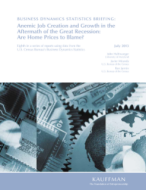
An official website of the United States government
Here’s how you know
Official websites use .gov
A .gov website belongs to an official government organization in the United States.
Secure .gov websites use HTTPS
A lock (
) or https:// means you’ve safely connected to the .gov website. Share sensitive information only on official, secure websites.
-
//
- Census.gov /
- Library /
- Publications /
- Anemic Job Creation in the Aftermath of the Great Recession
Anemic Job Creation in the Aftermath of the Great Recession
Anemic Job Creation in the Aftermath of the Great Recession
Abstract
The economic downturn of 2007–09 is one of the two largest cyclical downturns experienced in the United States in the post-WWII era—the other being the 1982–83 downturn. This period stands out not just for the magnitude of the downturn but also for the slow pace of the recovery. For example, the 1982–83 downturn was characterized by a rapid recovery. In contrast, the recovery from the 2007–09 downturn has been relatively anemic. Using data from the newest release of the BDS, Figure 1 shows that the 1982–83 downturn saw net job creation fall from 1.3 percent in 1980 (the difference between job creation and job destruction) to -2.4 percent in 1983. This was followed by a rapid recovery from 1983 through 1985, with a net job growth in 1984 of 6.3 percent followed by 5.2 percent in 1985. The job creation rate spiked upward in 1984 and remained high for several years. The 2007–09 downturn saw net job growth decline from 3.5 percent in 2006 to -5.1 percent in 2009. Net job growth increased to -1.7 percent in 2010 and 2.4 percent in 2011. The
anemic recovery was not due to job destruction remaining high (the job destruction rate in 2011 was below the 2006 rate), but due to anemic job creation. The job creation rate in 2006 was 16.4 percent. It fell to 11.6 percent in 2009 and had only recovered to 14.1 percent by 2011. This implies that the number of (gross) jobs created annually fell from 19.1 million in 2006 to 13.5 million in 2009 and only recovered to 15.7 million by 2011.
Share
Some content on this site is available in several different electronic formats. Some of the files may require a plug-in or additional software to view.
 Yes
Yes
 No
NoComments or suggestions?


Top

